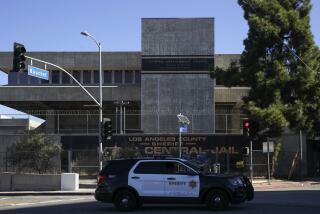At Chino, mute evidence speaks of riot’s violence
- Share via
CHINO — Charred cotton mattress stuffing is heaped on a scruffy lawn outside Joshua Hall dormitory at the California Institution for Men, the interior ankle-deep in ash and evidence of inmate-on-inmate brutality that has destroyed precious space in one of the state’s most volatile prisons.
In neighboring Otay Hall, dried blood stains a lower bunk mattress where a reclining inmate’s chest would be, two deep gashes in the fabric suggesting a stab wound.
Between the two dorms -- one destroyed by fire, the other smashed and debris-strewn -- stands an empty carton marked “White Kittey,” testifying to the racial divides that run deep among the facility’s 5,900 prisoners.
“Every race has a kitty -- its own collection of items from toiletries like soap and shampoo up to controlled substances,” Lt. Mark Hargrove said Tuesday of the inmates’ internal practices of sharing with only their own kind.
The practice undermines state corrections officials’ efforts to combat segregation, but faced with overwhelming numbers -- 200 men are usually under guard by only two officers -- authorities say they are powerless to break the color barriers.
“We don’t allow them -- they just do it,” Hargrove said with a shrug.
The contents of the white prisoners’ kitty -- and presumably that of blacks, Latinos and Native Americans as well -- are strewn among the bedding, laundry, books, food and personal letters hurled into the yard during a Saturday night rampage that injured 175 prisoners and forced evacuation of all 1,600 men from the eight-dorm compound called Reception Center West.
It was the kind of explosive violence threatened throughout the state’s 33 prisons, which are packed with nearly twice as many inmates as they were built to hold. The destruction wreaked here has served to intensify pressures throughout the penal system as at least 1,100 Chino inmates have been moved to other prisons.
The prison remains on lockdown, in a “state of emergency,” Hargrove said as he picked his way through the riot scene.
The two dormitories hardest hit by the clashes are surrounded by yellow crime scene tape. Trash bags line the chain-link fence topped with concertina wire. Olive-clad security officers comb the grassy field with metal detectors, looking for weapons the prisoners might have buried during the four hours that they had control of the area.
Corrections officers got word that violence was brewing at the prison, prompting a lockdown imposed Thursday night. Tensions between Latino and black prisoners flared two days later, according to officers here.
But in the end, inmates of every race were involved, leaving the cause of the clash unclear, said Terry Thornton, spokeswoman for the California Department of Corrections and Rehabilitation.
The detritus covering the yard between the Otay and Joshua dorms offers a mosaic of daily life in the prison.
Gang identity cards flutter in a hot breeze wafting over the wreckage, an acrid smell of incinerated wood and cloth hanging heavy in the stifling air.
A large plastic bottle of 800-milligram ibuprofen, crushed packages of ramen noodles, Suave shampoo and Lubriderm lotion, spilled dominoes and ripped-up playing cards have been tossed with orange pull-on pants, bloodstained socks and T-shirts, towels and paperbacks and letters from home that carpet the grass.
Arriving inmates are supposed to spend no more than 60 days at the reception centers, ideally less, if each newcomer can be vetted quickly for gang affiliation and potential security concerns, Hargrove said. But many remain in the volatile intake facilities for 90 days, often longer.
Chino authorities said they did not know when the damaged dorms would be repaired and repopulated, although some in plant operations have been talking about reopening the more intact bunkhouses in as little as three weeks, Hargrove said.
--
More to Read
Sign up for Essential California
The most important California stories and recommendations in your inbox every morning.
You may occasionally receive promotional content from the Los Angeles Times.











